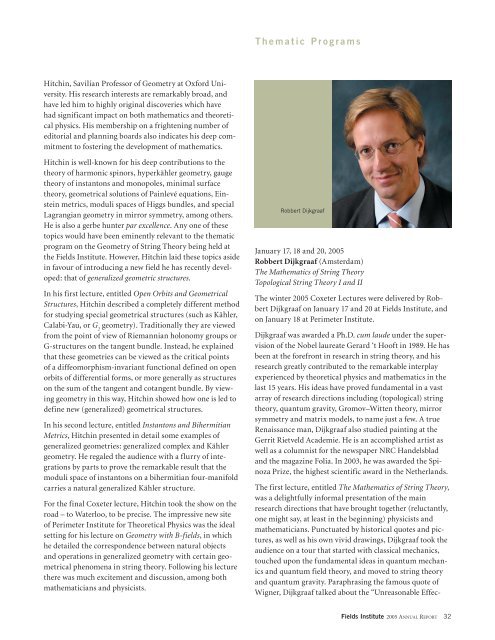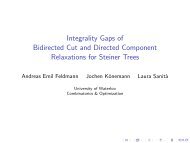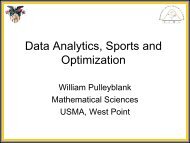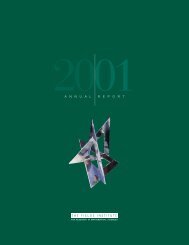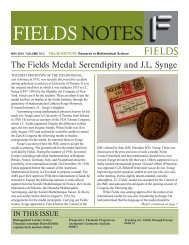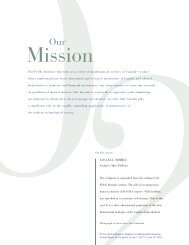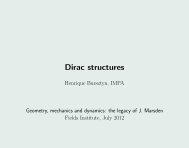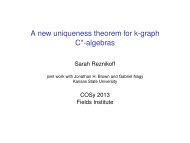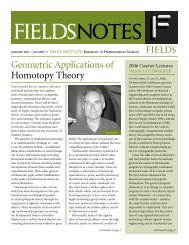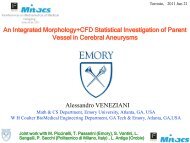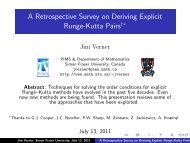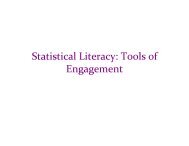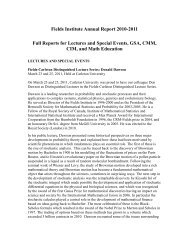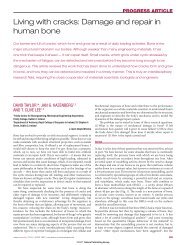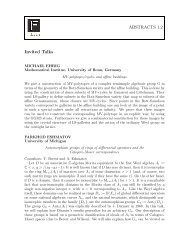Annual Report 2005 - Fields Institute - University of Toronto
Annual Report 2005 - Fields Institute - University of Toronto
Annual Report 2005 - Fields Institute - University of Toronto
Create successful ePaper yourself
Turn your PDF publications into a flip-book with our unique Google optimized e-Paper software.
Hitchin, Savilian Pr<strong>of</strong>essor <strong>of</strong> Geometry at Oxford <strong>University</strong>.<br />
His research interests are remarkably broad, and<br />
have led him to highly original discoveries which have<br />
had significant impact on both mathematics and theoretical<br />
physics. His membership on a frightening number <strong>of</strong><br />
editorial and planning boards also indicates his deep commitment<br />
to fostering the development <strong>of</strong> mathematics.<br />
Hitchin is well-known for his deep contributions to the<br />
theory <strong>of</strong> harmonic spinors, hyperkähler geometry, gauge<br />
theory <strong>of</strong> instantons and monopoles, minimal surface<br />
theory, geometrical solutions <strong>of</strong> Painlevé equations, Einstein<br />
metrics, moduli spaces <strong>of</strong> Higgs bundles, and special<br />
Lagrangian geometry in mirror symmetry, among others.<br />
He is also a gerbe hunter par excellence. Any one <strong>of</strong> these<br />
topics would have been eminently relevant to the thematic<br />
program on the Geometry <strong>of</strong> String Theory being held at<br />
the <strong>Fields</strong> <strong>Institute</strong>. However, Hitchin laid these topics aside<br />
in favour <strong>of</strong> introducing a new field he has recently developed:<br />
that <strong>of</strong> generalized geometric structures.<br />
In his first lecture, entitled Open Orbits and Geometrical<br />
Structures, Hitchin described a completely different method<br />
for studying special geometrical structures (such as Kähler,<br />
Calabi-Yau, or G 2 geometry). Traditionally they are viewed<br />
from the point <strong>of</strong> view <strong>of</strong> Riemannian holonomy groups or<br />
G-structures on the tangent bundle. Instead, he explained<br />
that these geometries can be viewed as the critical points<br />
<strong>of</strong> a diffeomorphism-invariant functional defined on open<br />
orbits <strong>of</strong> differential forms, or more generally as structures<br />
on the sum <strong>of</strong> the tangent and cotangent bundle. By viewing<br />
geometry in this way, Hitchin showed how one is led to<br />
define new (generalized) geometrical structures.<br />
In his second lecture, entitled Instantons and Bihermitian<br />
Metrics, Hitchin presented in detail some examples <strong>of</strong><br />
generalized geometries: generalized complex and Kähler<br />
geometry. He regaled the audience with a flurry <strong>of</strong> integrations<br />
by parts to prove the remarkable result that the<br />
moduli space <strong>of</strong> instantons on a bihermitian four-manifold<br />
carries a natural generalized Kähler structure.<br />
For the final Coxeter lecture, Hitchin took the show on the<br />
road – to Waterloo, to be precise. The impressive new site<br />
<strong>of</strong> Perimeter <strong>Institute</strong> for Theoretical Physics was the ideal<br />
setting for his lecture on Geometry with B-fields, in which<br />
he detailed the correspondence between natural objects<br />
and operations in generalized geometry with certain geometrical<br />
phenomena in string theory. Following his lecture<br />
there was much excitement and discussion, among both<br />
mathematicians and physicists.<br />
T h e m a t i c P r o g r a m s<br />
Robbert Dijkgraaf<br />
January 17, 18 and 20, <strong>2005</strong><br />
Robbert Dijkgraaf (Amsterdam)<br />
The Mathematics <strong>of</strong> String Theory<br />
Topological String Theory I and II<br />
The winter <strong>2005</strong> Coxeter Lectures were delivered by Robbert<br />
Dijkgraaf on January 17 and 20 at <strong>Fields</strong> <strong>Institute</strong>, and<br />
on January 18 at Perimeter <strong>Institute</strong>.<br />
Dijkgraaf was awarded a Ph.D. cum laude under the supervision<br />
<strong>of</strong> the Nobel laureate Gerard ‘t Ho<strong>of</strong>t in 1989. He has<br />
been at the forefront in research in string theory, and his<br />
research greatly contributed to the remarkable interplay<br />
experienced by theoretical physics and mathematics in the<br />
last 15 years. His ideas have proved fundamental in a vast<br />
array <strong>of</strong> research directions including (topological) string<br />
theory, quantum gravity, Gromov–Witten theory, mirror<br />
symmetry and matrix models, to name just a few. A true<br />
Renaissance man, Dijkgraaf also studied painting at the<br />
Gerrit Rietveld Academie. He is an accomplished artist as<br />
well as a columnist for the newspaper NRC Handelsblad<br />
and the magazine Folia. In 2003, he was awarded the Spinoza<br />
Prize, the highest scientific award in the Netherlands.<br />
The first lecture, entitled The Mathematics <strong>of</strong> String Theory,<br />
was a delightfully informal presentation <strong>of</strong> the main<br />
research directions that have brought together (reluctantly,<br />
one might say, at least in the beginning) physicists and<br />
mathematicians. Punctuated by historical quotes and pictures,<br />
as well as his own vivid drawings, Dijkgraaf took the<br />
audience on a tour that started with classical mechanics,<br />
touched upon the fundamental ideas in quantum mechanics<br />
and quantum field theory, and moved to string theory<br />
and quantum gravity. Paraphrasing the famous quote <strong>of</strong><br />
Wigner, Dijkgraaf talked about the “Unreasonable Effec-<br />
<strong>Fields</strong> <strong>Institute</strong> <strong>2005</strong> ANNUAL REPORT 32


